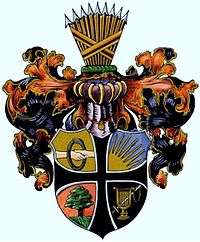German Burschenschaft
The German Burschenschaft (DB) (Deutsche Burschenschaft) is a corps-association of fraternities; a co-operation of student associations of a certain form in Germany and Austria. It was created in 1881 as a General Deputies Convent (ADC) and received its current name in 1902. It goes back to the ideas associated with the founding of the native fraternetie (Urburschenschaft) in Jena in the year 1815. The ideal goals are outlined in the motto "Honor - Freedom - Fatherland".
 | |
| Abbreviation | DB |
|---|---|
| Formation | 1881 |
| Legal status | Foundation |
| Purpose | Academic |
Region served | |
Membership | 7,000 (as of 2019) |
Official language | German |
| Website | burschenschaft.de |
Today German Burschenschaft is considered as a right-wing corps. This status was preceded by internal directional struggles from the 2000s onwards, in which the German nationalistic fraternities prevailed.[1] According to their own numbers, Deutsche Burschenschaft has 7.000 members in almost 70 fraternities.[2]
History
In 1881, the "General Deputies Convent" (“Allgemeiner Deputierten-Convent”) was founded by 35 fraternities in Eisenach, renamed "German Burschenschaft" in 1902. The members agreed on commonalities in general student and student affairs, but in a number of other matters the individual fraternities should decide for themselves. A recording of Austrian Burschenschaft was initially rejected for the reason that the association at that time "basically rejected the active participation in political issues" according to the statement on the website of Deutsche Burschenschaft. When in 1919 the Treaty of St. Germain was made and the unification of Germany and Austria into a Großdeutsches Reich got impossible, the Deutsche Burschenschaft merged with the Austrian "Burschenschaft der Ostmark". In its understanding, at least the Burschenschaften unite the German fatherland.[3][4]
In a number of participating Burschenschaften antisemitism was common; all members had to confess Christianity. Judaism was not seen as a religion, more as a ‘race’. Resulting from several disputes at the annual Burschentag (fraternity day) in 1920 it was established that membership was not open to Jews or descendants of Jews or people whose fianées had Jewish ancestors. In addition, many Burschenschafter were against the first German Republic, the so-called Weimarer Republik and they scattered to accept the defeat in the first world war.[5]
In 1996 some liberal-conservative Burschenschaften stepped out of Deutsche Burschenschaft and founded the “New German Burschenschaft”. In 2011 there were a debate at Burschentag in Eisenach about a so-called “Ariernachweis” for members. Two years later this proposal was secluded. Nevertheless, some associations left Deutsche Burschenschaft and the numbers of members were cut in half. Some of the Burschenschaften stepped into “New German Burschenschaft” and some others founded in 2016 the “General German Burschenschaft”.[6]
In 2014 the executive committee of German socialdemocratic party SPD made a "incompatibility decision". It forbids belonging to both the SPD and a fraternity, which is organized in the umbrella organization Deutsche Burschenschaft. SPD reacted to the ongoing radicalization of DB and the "increasingly nationalist and Greater German program". That is incompatible with the values of social democracy. [7]
Traditionally there were two wings in the German Burschenschaft: conservative on one side and völkisch or extreme-right members on the other side. The newspaper tageszeitung wrote in 2018, that for a long time, DB had seen itself as "nonpartisan - from the CDU / CSU on the Republicans to the NPD".[8] But when Alternative for Germany (AfD) gained strength in German Burschenschaft the right-winged members gained more influence. Especially the AfD-Youth Organization "Young Alternative" became attractive for fraternity members. According to an AfD-member of paralament of Nordrhein-Westfalia, about 20 percent of Young Alternative members are also organized in fraternities by 2018.
Notable members
- Hans Furler, CDU politician and President of the European Parliament
- Albrecht Glaser, AfD politician
- Martin Graf, FPÖ politician (Burschenschaft Olympia)[9]
- Christian Hafenecker, FPÖ politician (Burschenschaft Nibelungia)[9]
- Hans-Jörg Jenewein, FPÖ polictican (Burschenschaft Nibelungia)[9]
- Peter Ramsauer, CSU politician[10]
- Martin Sellner, fascist activist (former Burschenschaft Olympia, now Sängerschaft Barden)[11]
- Harald Stefan, FPÖ politician (Burschenschaft Olympia)[9]
- Christian Wirth, AfD politician
- Jörg Schneider, AfD politician
- Axel Kassegger, FPÖ politician (Burschenschaft Thessalia, Burschenschaft Germania Graz)[9]
- Norbert Nemeth, FPÖ politician (Burschenschaft Olympia)[9]
- Enrico Komning, AfD politician
- Benjamin Nolte, AfD politician
- Philipp Schrangl,FPÖ politician (Burschenschaft Oberösterreicher Germanen, Wien)[9]
Literature
- D. Heither (2004): Burschenschaften Rechte Netzwerke auf Lebenszeit. In: Rechte Netzwerke—eine Gefahr (pp. 133–145). VS Verlag für Sozialwissenschaften.
- H. Brunck (1999): Die Deutsche Burschenschaft in der Weimarer Republik und im Nationalsozialismus. München: Universitas.
References
- Dachverband Deutscher Burschenschaften: Abschied von jeglicher Liberalität, in: Süddeutsche Zeitung November 25, 2012;
- Deutscher Burschenschaft: Kurzporträt: Überblick, at: German Burschenschaft, July 7, 2019;
- "Deutsche Landsmannschaft (DL), 1868-1938". Bayerische Staatsbibliothek. Retrieved 11 November 2019.
- "Ursprung, Entwicklung und Werte von Burschenschaften (Roots, development and values of Burschenchaften)". Amadeu Antonio Stiftung. Retrieved 11 November 2019.
- Deutscher Bundestag, Scientific Department (2007). › resource › blob › WD-1-172-07-pdf-data https://www.bundestag.de › resource › blob › WD-1-172-07-pdf-data Check
|chapter-url=value (help)|chapter-url=missing title (help). Judenfeindschaft und Antisemitismus bei Kaiser Wilhelm II. Berlin, Germany: Deutscher Bundestag. Retrieved 27 October 2019.Judenfeindschaft und Antisemitismus bei Kaiser Wilhelm II. - "Against the right image". Frankfurter Allgemeine Zeitung. Retrieved 11 November 2019.
- SPD schließt Mitgliedschaft in Partei und DB aus, in: Der Spiegel June 26, 2014;
- "Aufbruchszeit für die Burschen". Die tageszeitung. Retrieved December 1, 2019.
- Um 14:17, 26 01 2018. "FPÖ: Die Burschenschafter im Nationalrat". Die Presse (in German). Retrieved 2019-12-26.CS1 maint: numeric names: authors list (link)
- "Fraternity Brothers: Questionable Polish Borders". German Foreign Policy. 4 July 2016.
- "Fakten zu den Burschenschaften - derStandard.de". DER STANDARD (in German). Retrieved 2019-12-26.